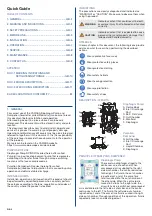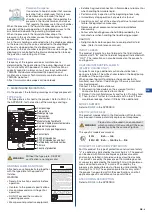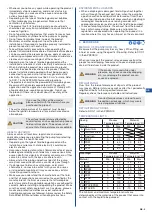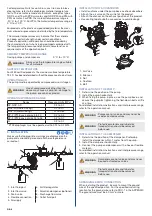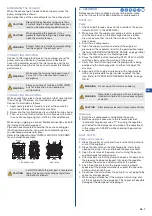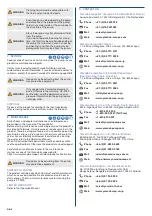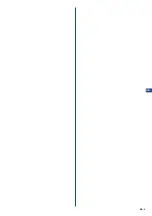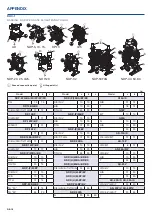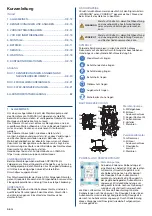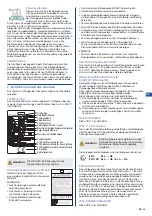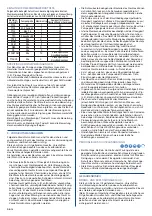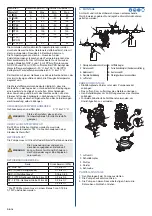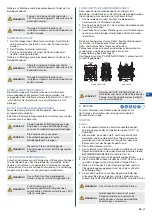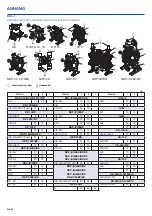
GB-7
GB
ARRANGING THE EXHAUST
When the exhaust point needs to be set up away from the
pump, arrange the exhaust.
Use a pipe/hose of the same diameter as the exhaust port.
CAUTION
Blocking the exhaust or using more than
5 meters length of exhaust pipe/hose may
lead to a decreased pump performance.
CAUTION
When operating the product, it may
generate loud operating noise, depending
upon the circumstances.
WARNING
Protect humans, animals and surrounding
facilities against the exhaust port.
CONNECTING AIR PIPING
Connect a filter regulator between the compressor and the
pump, and use a lubricator if required. Use a flexible air
hose with a diameter equal to the inlet air valve and the air
consumption. Keep the air line as short as possible for best
performance.
WARNING
Make sure the air valve is placed in such
a way, that it can be reached in case of
emergency.
WARNING
Always use Class 1 turbine oil (ISO VG32)
only for lubrication in non-explosive
environments.
CONNECTING FLUID PIPING
When connecting a pipe or hose to the manifold, never tighten
it too strongly. Otherwise, the manifold may be damaged.
Connect to manifold as follows:
1. Apply sealing tape to a thread of a joint or the connector,
which need to be connected to the manifold.
2. Screw into the manifold correctly and tighten fully by hand.
3. Then, screw the thread further for two rounds with a tool.
In case of a leakage, tighten it little by little additionally.
When using a rigid pipe, connect flexible connections on both
the inlet and the discharge port.
Pipe and hose diameters should be the same as or bigger
than the pump port size. Long suction and discharge lines
can decrease pump performance.
Refer to the diagram under “INSTALLATION OF THE PUMP”
for an installation example.
CAUTION
For NDP-50FAN, the inlet port is located on
top of the pump. It discharges liquid from
the bottom side port.
OUTLET
INLET
OUTLET
INLET
OUTLET
INLET
NDP-50FAN
STANDARD PUMPS
6. OPERATION
Before connecting any pipes or hoses to the pump, make
sure that the system has been bled of all compressed air.
START-UP
Pump
1. Check all bolt torque values on the outside of the pump
(refer to DOC-1 in the APPENDIX).
2. Make sure that the supply and pump air valve, regulator
and the drain valve on the discharge side are closed.
Also, make sure that the inlet flow valve on the suction
side is open.
3. Start the air compressor.
4. Open the supply air valve and adjust the supply air
pressure with a regulator to within the permissible range
(Refer to OPERATING PRESSURE RANGE on page GB-6)
5. Open the flow valve on the discharge side.
6. Press the RESET button (excluding G15P, G15V and G25)
and then slowly open the air valve of the pump.
7. Verify that fluid is flowing inside the piping and is being
pumped to the discharge side, and then fully open the
air valve.
8. Again adjust the supply air pressure with a regulator to
within the permissible range in order to adjust the flow
rate. (Refer to OPERATING PRESSURE RANGE on page
GB-6)
WARNING
Do not open the air valve suddenly.
WARNING
Never block a leakage with any body part.
Injected materials can cause severe injury
or death.
CAUTION
Slow pump cycles result in less wear and tear.
Dampener
1. Start the air compressor and operate the pump.
2. Set the supply air pressure to the reference level of
“pump discharge pressure x 1.1” by using the regulator
connected to the dampener and make a fine adjustment
in the range of ±0.05 MPa while checking the pulsation
as required.
SHUT DOWN
Pump and Dampener
1. Close the supply air valve and the air valve of the pump to
shut off the supply air.
2. Close the flow valve on the discharge side, start slowly
opening the drain valve, and release the pressure fluid.
3. Open the air valve of the pump, start running the pump,
and discharge the remaining air.
4. After making sure that the pump has been shut down and
the pressure has been released, fully open the regulator,
and close the air valve and drain valve of the pump.
5. Flush the entire system with a proper cleaning liquid,
especially if the pumped material is subject to expansion
or dry-out when not in use.
6. Disconnect the air line from the pump if it is not going to be
active for a longer period.
7. When using a dampener: if the pump is not running, shut
off the air supply to the dampener. This to prevent possible
damage of the dampener’s diaphragm.


